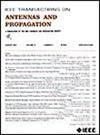Dual-Polarized MIMO UAV-to-Ground Tree Shadowed Channel: Capacity, Multiplexing, Stationarity, and Statistical Modeling Assessment
IF 5.8
1区 计算机科学
Q1 ENGINEERING, ELECTRICAL & ELECTRONIC
引用次数: 0
Abstract
This article presents an extensive performance analysis of a narrowband dual-polarized (DP) multiple-input-multiple-output (MIMO) communication link, between a low-altitude unmanned aerial vehicle (UAV) and a terrestrial terminal. The experimental campaign is conducted in an urban park, under tree shadowing environment. The ergodic capacities are calculated 5.2 b/s/Hz for line-of-sight (LOS), and 4.4 b/s/Hz for nonline-of-sight (NLOS) trajectories, respectively, substantially enhanced compared with the single-input-single-output (SISO) cases. The encountered capacity variations are associated with the propagation geometry and the UAV flight path, as well as with the elevation angle and distance between the related terminals. From the multiplexing assessment analysis, the DP-MIMO channel has been shown its favorability for adopting beamforming methods. A new stochastic model is also suggested that represents the channel matrix employing jointly the inverse Gaussian and Rayleigh distributions. Promising results are delivered, where the adopted model predicts conveniently the channel capacity under the existence of tree shadowing. Finally, shorter stationarity periods are observed under the tree presence affecting their pattern and, in respect, the achieved instantaneous capacity.双极化MIMO无人机对地树影信道:容量,多路复用,平稳性和统计建模评估
本文对低空无人机(UAV)和地面终端之间的窄带双极化(DP)多输入多输出(MIMO)通信链路进行了广泛的性能分析。实验活动在一个城市公园里,在树荫下进行。经过计算,视距(LOS)和非视距(NLOS)轨迹的遍历能力分别为5.2 b/s/Hz和4.4 b/s/Hz,与单输入-单输出(SISO)情况相比,遍历能力大大提高。遇到的能力变化与传播几何形状和无人机飞行路径以及仰角和相关终端之间的距离有关。从多路复用评估分析来看,DP-MIMO信道具有采用波束形成方法的优越性。本文还提出了一种新的随机模型,该模型采用逆高斯分布和瑞利分布来表示信道矩阵。所采用的模型能够方便地预测存在树影条件下的信道容量,取得了令人满意的结果。最后,在树的存在下观察到较短的平稳期,影响它们的模式,并且就实现的瞬时容量而言。
本文章由计算机程序翻译,如有差异,请以英文原文为准。
求助全文
约1分钟内获得全文
求助全文
来源期刊
CiteScore
10.40
自引率
28.10%
发文量
968
审稿时长
4.7 months
期刊介绍:
IEEE Transactions on Antennas and Propagation includes theoretical and experimental advances in antennas, including design and development, and in the propagation of electromagnetic waves, including scattering, diffraction, and interaction with continuous media; and applications pertaining to antennas and propagation, such as remote sensing, applied optics, and millimeter and submillimeter wave techniques

 求助内容:
求助内容: 应助结果提醒方式:
应助结果提醒方式:


